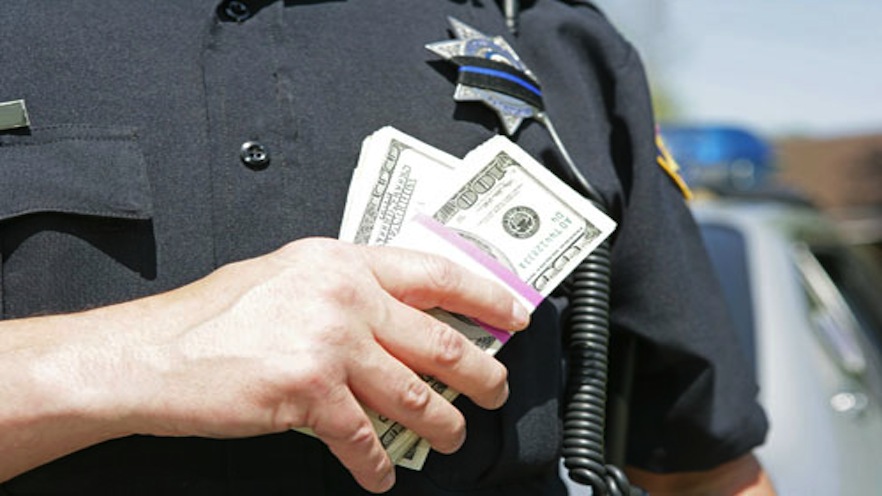News
One Local Cop Earned $442,000: How Police Rob Taxpayers Blind in Pay, But Refuse to Reform

Precisely how much dough can be had as a badge-and-gun-wielding government enforcer of laws can best be explained in the head-scratching case of a local school safety cop in New York, who hauled in a stark $442,000 — just under two and a half times that of New York Governor Andrew Cuomo’s $179,000 — as well as by the fact that, across the United States, the aforementioned, now-retired officer wasn’t an exception.
In critiques of American policing, the levels of corruption, boot camp training, hostile workplace atmospheres, militarism, vehement codes of silence and insular issues, veritable impunity from consequence for wrongdoing, and many other topics frequent lists of problems to be dealt with, solved, or reformed out of existence to move forward in progress — but officer pay rarely makes the floor of public debate.
Perhaps it should.
On Wednesday, the Empire Center released its annual “What They Make” report detailing the salaries of local government workers throughout New York; and — if you thought cops had it rough for the pay — it turns out, police in some areas are laughing all the way to the bank. Note, however, criticism of taxpayer-funded salaries and compensation in no way equates condemnation of that occupation; but analyzing the data may provide reform efforts with a window into the blue line mindset.
Tom Donnelly, the now-retired Ramapo school safety officer with the several hundred thousand-dollar cushion, earned the largest paycheck of any police officer outside New York City — as one of almost 175,000 employees sharing $9.7 billion total paid in salary from taxes for the 12-month year ending on March 31, 2017, reports the Empire Center. Police in the Village of Kings Point — all twenty of them — earned the highest average pay in the entire state, at $220,088; but, none of them came close to New York’s highest paid law enforcement officer, who raked in $640,000 last year working for the NYPD.
Donnelly certainly manipulated the system within acceptable bounds to ensure the maximum payout for the last year on the job, as anyone approaching retirement would; but it’s imperative to note officers’ pensions are most often based on the income earned their last year on the job — meaning that several hundred thousand dollars paid the last year could help set what he earns in retirement, whether or not it’s actually reflective of career pay.
On average around the nation, an aspiring law enforcement officer could expect an annual income of around $52,305, according to data from Glassdoor, with pay for a lieutenant jumping to about $99,679 per year — though these figures are slightly higher than estimates from indeed.com, which places the former at $46,142, as recently as Tuesday. As of May 2016, however, the Bureau of Labor Statistics places the average pay for ‘Police and Sheriff’s Patrol Officers’ at $62,760, with a mean hourly rate of $30.17.
Unsurprisingly, given the vast differences in cost of living from coast to coast and everywhere within the borders of the U.S., the State’s enforcers of the law earn substantially contrasting salaries for the ostensive performance of similar duties depending upon location — but geography shouldn’t serve as sufficient grounds to dismiss how much of the nation’s income in tax dollars pays cops.
“Personnel costs are the biggest part of most local government budgets, and thereby the biggest driver behind our high property taxes,” Empire Center Executive Director Tim Hoefer asserted, adding, “This report provides a tool for local officials and taxpayers who want to see how their community stacks up.”
Residents of multiple cities and towns around the country may be shocked to discover their incomes dwarfed in size by those of officers supposedly sworn to protect and serve. Indeed, a report from NJ Advance Media in May found 60 percent of municipal law enforcement officers in New Jersey earned at least $100,000 in annual pay in 2016 — 30 percent higher than that figure in 2009 — as the median salary increased by 16 percent, or $14,400, to a striking $105,106.
What police are actually paid appears to be somewhat a murky question, as yet another report, this one from Cheat Sheet and published today, shows the highest earning cops in the nation hail from California, pulling in a statewide average salary of $93,550, with officers in the San Jose/Sunnyvale/Santa Clara region at the pinnacle, with an average of $114,520.
While there certainly exists a flip side to officers earning questionable sums (Mississippi’s police average just $33,350 in annual pay) and a well-but-reasonably-paid intermediate average for officers nationwide, that salaries of even non-specialized cops rival those of more dangerous, specialized, and private occupations — all on the taxpayer’s dime.
Without so much as a toe tip dipped here in the fraught issue of violence and corruption in policing in America, it might especially behoove the taxpaying individuals in communities where law enforcement is more notorious than beneficent to evaluate efficacy and cost. Perhaps pay may be a means to hold police accountable for their transgressions when courts and superiors fail to do so.
What law enforcement officers actually earn could surprise you — and may spark sufficient criticism for reform.
Typos, corrections and/or news tips? Email us at Contact@TheMindUnleashed.com
